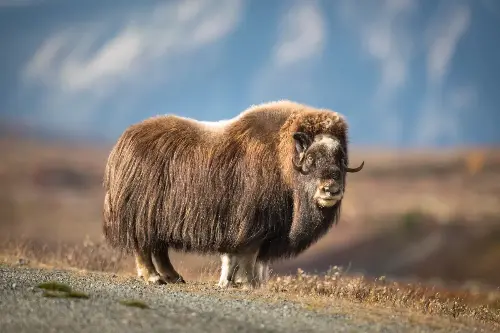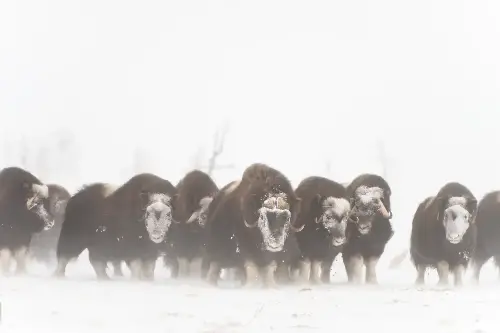Imposing and shaggy, the Arctic muskox is a symbol of stoic endurance in the face of extreme environmental challenges. These ancient creatures, whose lineage can be traced back to the last Ice Age, are an incredible tale of adaptation and survival that continues to unfold against the harsh, icy backdrop of the Arctic tundra.
Evolution has equipped the muskox with a suite of impressive adaptations that allow it to thrive where few large mammals dare to tread. Beneath their long, outer coat lies a finer, incredibly dense underlayer known as qiviut. This underwool is acclaimed for being softer than cashmere and eight times warmer than sheep's wool, rendering the muskox well-insulated against the biting Arctic cold.

The ancestors of the modern muskox roamed the earth during the Pleistocene era, alongside mammoths and sabre-toothed tigers. Remarkably, these Ice Age survivors have walked paths that date back tens of thousands of years, a journey marked by ecological changes and human history.
Palaeontologists suggest that during the last glacial maximum, muskoxen inhabited a broad swath of terrain that stretched from western Europe, across northern Asia, and into North America via the land bridge that once connected Siberia to Alaska. As the planet warmed and the Ice Age retreated, muskox populations also migrated north, tracking the retreating ice and tundra into the Arctic regions where they predominantly reside today.
Perhaps the most enduring testament to the resilience of the muskox is its ability to survive these climatic gyrations, not only outlasting the megafauna of its era but also continuing to roam the icy expanses of Greenland, Northern Canada, and Siberia.
In terms of social construct, the muskox exhibits intriguing behaviors. These herbivores form close-knit groups, frequently seen arranged in defensive circles with their young at the centre when predators such as wolves are near. This distinctive formation, coupled with their thick, helmet-like skulls, enables them to effectively thwart predators.

This collaborative social structure also aids in foraging during the lean winter months. Muskoxen utilise their hooves to dig through snow to reach the frozen plant matter below, working as a group to uncover enough sustenance to sustain the entire herd.
While they may appear slow and cumbersome, muskoxen can charge at speeds of up to 37 kilometres per hour when threatened. They have also been known to stand their ground against some of the Arctic's most formidable carnivores, including bears and packs of wolves.
Despite their remarkable adaptations, muskoxen are not insusceptible to modern challenges. Climate change poses a particular threat, disrupting the fragile Arctic ecosystem on which they depend. Warmer temperatures can affect the quality of their foraging grounds and increase the range of pests and diseases to which muskoxen have little natural resistance.
Human activity has also had a historical impact on muskox populations. Overhunting during the 19th and early 20th centuries led to their extinction in Alaska and severely diminished numbers elsewhere. Conservation efforts, including relocations and legal protections, have since helped their numbers to rebound, reflecting a rare conservation success story.

As an emblem of the Arctic's enduring wildlife and the importance of conservation, muskoxen have much to teach us. They inspire clothing made from qiviut, which provides sustainable income for indigenous communities, and they captivate the imagination with their prehistoric appearance and resilient natures.
To observe a muskox in the wild is to witness a living relic of the Ice Age, navigating the challenges of the contemporary world with the same tenacity that saw it graze alongside glaciers and withstand the tests of millennia. They are not just survivors but also representatives of the Arctic's indomitable spirit—a spirit that calls for our respect and protection as the climate and environment continue to change around them.
The future of the muskox is uncertain as it hinges on the balance between conservation efforts and the rapid environmental changes sweeping the polar regions. Nevertheless, the story of the muskox—its past, present, and future—remains a magnificent narrative of perseverance and the incredible capacity for life to adapt to the harshest of circumstances. They are, in every right, a symbol of the Arctic's wild heart and a testament to the enduring splendour of nature's creations.
